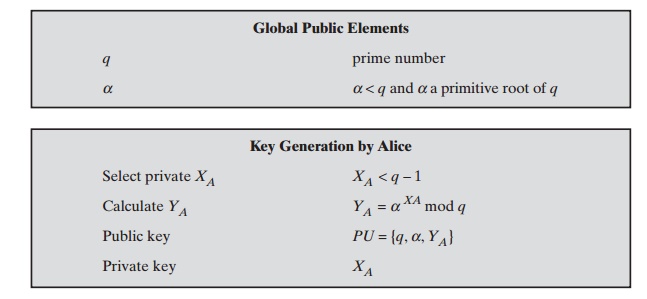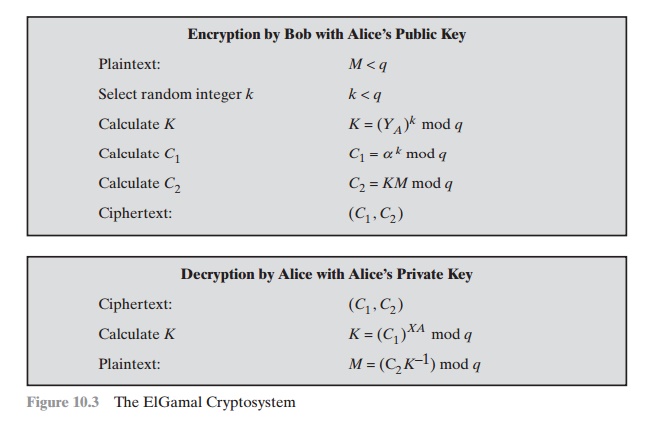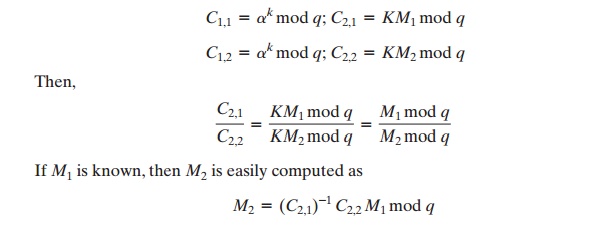Chapter: Cryptography and Network Security Principles and Practice : Asymmetric Ciphers : Other Public-Key Cryptosystems
Elgamal Cryptographic System
ELGAMAL CRYPTOGRAPHIC SYSTEM
In
1984, T. Elgamal announced a public-key scheme based on discrete
logarithms, closely related to the Diffie-Hellman
technique [ELGA84, ELGA85]. The ElGamal2 cryptosystem is used in some form in a number of standards including
the digital signature standard
(DSS), which is covered in Chapter 13, and the S/MIME
e-mail standard (Chapter 18).
As with Diffie-Hellman, the global
elements of ElGamal
are a prime number q and a, which is a primitive root of q. User
A generates a private/public key pair as follows:
1.
Generate a random integer XA, such that 1 6 XA 6 q - 1.
2.
Compute YA = aXA mod q .
3.
A’s private
key is XA; A’s pubic key is {q, a, YA}.
Any user B that has access to A’s public key can encrypt a message
as follows:
1.
Represent the message as an integer M in the range 0 … M … q - 1. Longer messages are sent as a sequence of
blocks, with each block being an integer less than q.
2.
Choose a random integer k such that 1 … k … q - 1.
3.
Compute a one-time key K = (YA)k mod q .
4.
Encrypt M as the pair of integers (C1, C2) where
C1 = ak mod
q;
C2 = KM mod q
User A recovers the plaintext as follows:
1.
Recover the key by computing K = (C1)XA mod q .
2.
Compute M = (C2K-1)
mod q .
These steps are summarized in Figure 10.3.
It corresponds to Figure 9.1a:
Alice generates a public/private key pair; Bob
encrypts using Alice’s
public key; and
Alice decrypts using her private key.
Let us demonstrate why the ElGamal scheme
works. First, we show how K is
recovered by the decryption process:
K = (YA)k mod q K is
defined during the encryption process
K = (aXA mod q)k mod q substitute using YA = aXA mod q K = akXA mod q by the rules
of modular
arithmetic
K = (C1)XA mod q substitute using C1 = ak mod q
Next, using K, we recover the
plaintext as
C2 = KM mod q
(C2K-1)
mod q
= KMK-1 mod
q = M mod
q = M
We can restate the ElGamal process as follows, using Figure 10.3.
1.
Bob generates a random integer k.
2.
Bob generates a one-time
key K using Alice’s public-key components YA, q, and k.
3.
Bob
encrypts k using the
public-key component a, yielding C1. C1 provides suffi-
cient information for Alice to recover
K.
4.
Bob encrypts
the plaintext message
M
using K.
5.
Alice recovers K from C1 using her private
key.
6.
Alice
uses K-1 to recover
the plaintext message
from C2.


Thus, K functions as a one-time
key, used to encrypt
and decrypt the message.
For example, let us start with the prime field GF(19); that is, q = 19.
It has primitive roots {2, 3, 10, 13, 14, 15}, as shown in Table 8.3. We choose
a = 10.
Alice generates a key pair as follows:
1.
Alice chooses XA = 5.
2.
Then YA = a XA mod q = a5 mod 19 = 3 (see Table 8.3).
3.
Alice’s private key is 5; Alice’s pubic key is {q, a, YA} = {19, 10, 3}.
Suppose Bob wants to send the message with the value M = 17.
Then,
1.
Bob chooses k = 6.
2.
Then K = (YA)k mod q = 36 mod 19 = 729 mod 19 = 7.
3.
So
C1 = ak mod
q = a6 mod
19 = 11
C2 = KM mod
q = 7 * 17
mod 19 = 119 mod 19 = 5
4.
Bob
sends the ciphertext (11, 5). For decryption:
1.
Alice calculates K = (C1)XA mod q =
115 mod
19 = 161051 mod
19 = 7.
2.
Then K
-1 in
GF(19) is 7-1 mod
19 = 11.
3. Finally, M
= (C2K- 1) mod q = 5 * 11 mod
19 = 55 mod 19 = 17.
If a message must be broken up into blocks and sent as
a sequence of encrypted blocks, a unique value of k should be used for each block. If k is used for more
than one block,
knowledge of one block m1 of
the message enables
the user to compute other blocks as follows. Let

The
security of ElGamal is based on the difficulty of computing discrete
logarithms. To recover A’s private key, an adversary would have to compute XA = dloga,q(YA) .
Alternatively, to recover the one-time key K,
an adversary would have to determine the random number k, and this would require comput- ing the discrete logarithm k = dloga,q(C1). [STIN06]
points out that these calcu- lations are regarded as infeasible if p is at least 300 decimal digits and q - 1 has
at least one “large” prime factor.
Related Topics